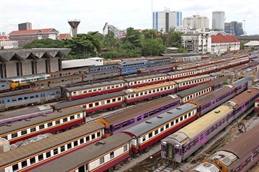
Improvements to infrastructure were a key a theme of the Greater Mekong Investment Forum held in Bangkok.
And the forum heard some good news.
Firstly, a rail link now connects Thailand and Cambodia, reported Kanit Sangsubhan, secretary general of the Eastern Economic Corridor Office of Thailand. This service connecting Bangkok with the Thai-Cambodian border started on July 1, 45 years after the rail link was severed by Pol Pot’s Khmer Rouge.
Twice daily trains each way will run between Bangkok and Ban Klong Luk Border Station in Sa Kaeo province, where there is a border market.
This in an incremental gain for the rail network in Thailand and brings nearer putting in place a bigger missing link in the Trans-Asian Railway (TAR). Its other significance, as Sangsubhan pointed out, is in what it heralds: an onland connection into Cambodia. “It will be extended to Phnom Penh,” he said.
This is not a solitary project, as he pointed out there are special economic zones being built along the emerging Kunming to Singapore axis as well. There are plans for a rail link along this but as the link involves four countries, several possible operating systems and two big overseas investors, it is very early days with regard to that project.
“We are promoting special economic zones,” said Sangsubhan. “The next one we are going to do is Khon Kaen and Cha Cheong Sao to link the North-South with the East-West Economic Corridor.”
Paralleling this, and shortly to be announced, are developments on the four big projects making up the Eastern Economic Corridor. In terms of cargo, this includes the third phases of both Laem Chabang and Map Ta Phut seaports as well as the development of U-Tapao, formerly a military airport, into an ‘Aviation City’ with a cargo village.
“All these projects, the big four projects will complete in four to five years,” said Sangsubhan. The fourth project is a high-speed railway network, moving passengers, initially, and maybe, one day, certain types of high-value cargo.
(Supporting this, at the Bangkok Post Forum where transport minister Saksayam Chidchob
– who focuses much more on passengers than cargo – added that there are plans to adjust, i.e., restrict, the hours that trucks can move in Bangkok.)
Thailand may lead the way, but other Mekong countries are also making progress, albeit sometimes unevenly, a session covering infrastructure, was told. Opinions varied, with Laos providing an interesting case.
Southeast Asia’s landlocked country was branded the most challenging by Shuji Hashizume, senior investment specialist in the infrastructure finance division of the private sector operation department of the Asian Development Bank.
Against this, Laos has potential for both logistics and transport, said Peter Shultz, senior vice president of infrastructure investor Infunde Development.
Cambodia has a similar role as its agrarian economy gears up to support China, among others, Shultz pointed to the benefits the China-funded roads, particularly the highway connecting Phnom Penh to Sihanoukville, have brought about in this respect. “That’s a big plus,” he said.
Analyzing the risks and opportunities, a consensus emerged that the trade war between the US and China will not derail either the region’s economic development or its building of infrastructure – indeed there was the odd hint it might create an opening for ASEAN, with Vietnam being cited several times as one country likely to benefit from the spat.
Similarly, China’s Belt and Road Initiative, which is met with trepidation in some parts of the world, such as Pakistan and Malaysia, is seen as having a limited impact so far in Southeast Asia, although its role as a catalyst was broadly approved.
Where there is opportunity is in smart manufacturing, possibly allowing countries in the region to leapfrog their rivals and move dramatically up the value chain. The technology is there to facilitate it, speakers agreed. There is also a role for blockchain, just as there was a presentation by UCK Network, one of China’s emerging blockchain companies.
The problem, though, is people.
“The obstacle we are facing sometimes is the mentality,” said Jeremy Tan, industrial sector executive at IBM Asia Pacific. “We need people who can understand the IOT (internet of things).”
By Michael Mackey
Southeast Asia Correspondent | Bangkok




